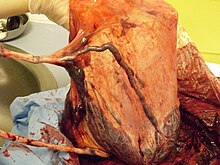Insertio velamentosa
An insertio velamentosa (from Latin: insertio, insertionis (f): insertion, attachment and Latin: velamentum, velamenti (n): sheath ) is understood in obstetrics to mean an anomaly of the umbilical cord insertion in which the vessels are free over the membranes run away. It is in contrast to the physiological umbilical cord insertions that attach directly to the placenta .
Epidemiology
With a frequency of around one percent of all singleton pregnancies, the insertio velamentosa is a relatively rare anomaly. The probability increases in the context of a multiple pregnancy. The diagnosis is usually made as an incidental finding after the birth of the placenta and is in very few cases recognizable before the onset of the rupture of the bladder.
Possible complications
Due to the unprotected course of the umbilical cord vessels, compression and the associated reduced blood supply can lead to non-chromosomally related malformations in the child at an early stage of pregnancy. As the pregnancy progresses, a deficiency may develop. Towards the end of pregnancy and during childbirth, a compressed vessel can cause the child to lack oxygen. The risk is especially higher when the vessels are near the cervix . A rupture of the bladder can in rare cases lead to injury to one or more of these vessels, which, depending on the extent, can result in profuse bleeding. Since this is exclusively the child's blood, there is an acute danger to life for the unborn child through bleeding.
Symptoms
As part of the vaginal examination, pulsating vessels on the membranes may be palpable when the cervix is open. With the onset of the rupture of the bladder, vaginal bleeding occurs; the CTG shows significant slowdowns in the child's heart rate. The mother's circulatory condition remains stable.
therapy
The urgency of the bleeding complication after a vascular injury requires immediate delivery. If the birth is imminent with the head down, it can be accelerated with the help of a vaginal surgical procedure such as vacuum extraction or obstetrical forceps . In all other cases, an emergency caesarean section is indicated if the child is still alive . Intensive medical care and blood transfusions may be necessary depending on the child's blood loss .
forecast
In the event of a rupture of the vessel with subsequent profuse bleeding, the prognosis for the child is to be classified as very poor. If the insertio velamentosa was diagnosed by chance after a birth without complications, the child can usually not expect any health damage. The likelihood that this abnormality will recur in the subsequent pregnancy is extremely low.
source
- Willibald Pschyrembel (greeting), Joachim Dudenhausen (editing): Pschyrembel . Practical obstetrics . Verlag Walter de Gruyter , Berlin 2008, ISBN 978-3-11-019074-8 .
